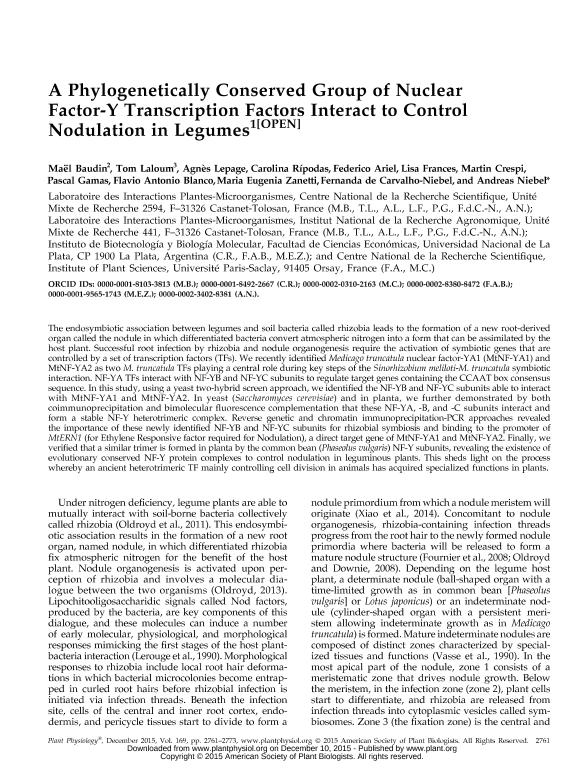Mostrar el registro sencillo del ítem
dc.contributor.author
Baudin, Maël
dc.contributor.author
Laloum, Tom
dc.contributor.author
Lepage, Agnes
dc.contributor.author
Rípodas, Carolina

dc.contributor.author
Ariel, Federico Damian

dc.contributor.author
Frances, Lisa
dc.contributor.author
Crespi, Martin
dc.contributor.author
Gamas, Pascal
dc.contributor.author
Blanco, Flavio Antonio

dc.contributor.author
Zanetti, María Eugenia

dc.contributor.author
de Carvalho-Niebel, Fernanda
dc.contributor.author
Niebel, Andreas
dc.date.available
2018-06-11T17:32:58Z
dc.date.issued
2015-10
dc.identifier.citation
Baudin, Maël; Laloum, Tom; Lepage, Agnes; Rípodas, Carolina; Ariel, Federico Damian; et al.; A phylogenetically conserved group of NF-Y transcription factors interact to control nodulation in legumes; American Society of Plant Biologist; Plant Physiology; 169; 10-2015; 2761-2773
dc.identifier.issn
0032-0889
dc.identifier.uri
http://hdl.handle.net/11336/48109
dc.description.abstract
The endosymbiotic association between legumes and rhizobia leads to the formation of root nodules in which differentiated bacteria convert atmospheric nitrogen into a form that can be assimilated by the host plant. Successful root infection by rhizobia and nodule organogenesis require the activation of symbiotic genes that are controlled by a set of early transcription factors (TFs). MtNF-YA1 and MtNF-YA2 are two TFs playing partially redundant functions during several steps of the symbiotic interaction between Medicago truncatula and Sinorhizobium meliloti. NF-Y proteins are part of a transcriptional complex composed of three proteins (NF-YA, NF-YB and NF-YC) which bind DNA at CCAAT-boxes, a motif present in most eukaryotic promoters. In plants, each subunit is encoded by small gene families, potentially leading to a multitude of heterotrimeric NF-Y complexes. Here, using yeast two hybrid screenings, we identified the MtNF-YB and MtNF-YC subunits that interact with MtNF-YA1 and A2. Further, we confirmed, both in yeast and in planta, the formation of trimeric NF-Y complexes and showed that these complexes are functional during nodulation using reverse genetic approaches and ChIP-PCR. Finally, as orthologs of the characterized NF-Y subunits also control nodulation in other legumes, we showed in common bean that similar NF-Y trimers could form in planta. Our results suggest that we have identified a group of evolutionary conserved NF-Y proteins that interact to control nodulation in leguminous plants.
dc.format
application/pdf
dc.language.iso
eng
dc.publisher
American Society of Plant Biologist

dc.rights
info:eu-repo/semantics/openAccess
dc.rights.uri
https://creativecommons.org/licenses/by-nc-sa/2.5/ar/
dc.subject
Transcription Factors
dc.subject
Nodulation
dc.subject
Medicago
dc.subject
Symbiosis
dc.subject.classification
Otras Ciencias Biológicas

dc.subject.classification
Ciencias Biológicas

dc.subject.classification
CIENCIAS NATURALES Y EXACTAS

dc.title
A phylogenetically conserved group of NF-Y transcription factors interact to control nodulation in legumes
dc.type
info:eu-repo/semantics/article
dc.type
info:ar-repo/semantics/artículo
dc.type
info:eu-repo/semantics/publishedVersion
dc.date.updated
2018-06-08T14:26:12Z
dc.journal.volume
169
dc.journal.pagination
2761-2773
dc.journal.pais
Estados Unidos

dc.journal.ciudad
Rockville
dc.description.fil
Fil: Baudin, Maël. Centre National de la Recherche Scientifique; Francia. Centre de Recherche de Nantes. Institut National de la Recherche Agronomique; Francia
dc.description.fil
Fil: Laloum, Tom. Centre National de la Recherche Scientifique; Francia. Centre de Recherche de Nantes. Institut National de la Recherche Agronomique; Francia
dc.description.fil
Fil: Lepage, Agnes. Centre National de la Recherche Scientifique; Francia. Centre de Recherche de Nantes. Institut National de la Recherche Agronomique; Francia
dc.description.fil
Fil: Rípodas, Carolina. Consejo Nacional de Investigaciones Científicas y Técnicas. Centro Científico Tecnológico Conicet - La Plata. Instituto de Biotecnología y Biología Molecular. Universidad Nacional de La Plata. Facultad de Ciencias Exactas. Instituto de Biotecnología y Biología Molecular; Argentina
dc.description.fil
Fil: Ariel, Federico Damian. Consejo Nacional de Investigaciones Científicas y Técnicas; Argentina. Centre D'etudes de Saclay; Francia
dc.description.fil
Fil: Frances, Lisa. Centre National de la Recherche Scientifique; Francia. Centre de Recherche de Nantes. Institut National de la Recherche Agronomique; Francia
dc.description.fil
Fil: Crespi, Martin. Centre D'etudes de Saclay; Francia
dc.description.fil
Fil: Gamas, Pascal. Centre National de la Recherche Scientifique; Francia
dc.description.fil
Fil: Blanco, Flavio Antonio. Consejo Nacional de Investigaciones Científicas y Técnicas. Centro Científico Tecnológico Conicet - La Plata. Instituto de Biotecnología y Biología Molecular. Universidad Nacional de La Plata. Facultad de Ciencias Exactas. Instituto de Biotecnología y Biología Molecular; Argentina
dc.description.fil
Fil: Zanetti, María Eugenia. Consejo Nacional de Investigaciones Científicas y Técnicas. Centro Científico Tecnológico Conicet - La Plata. Instituto de Biotecnología y Biología Molecular. Universidad Nacional de La Plata. Facultad de Ciencias Exactas. Instituto de Biotecnología y Biología Molecular; Argentina
dc.description.fil
Fil: de Carvalho-Niebel, Fernanda. Centre National de la Recherche Scientifique; Francia. Centre de Recherche de Nantes. Institut National de la Recherche Agronomique; Francia
dc.description.fil
Fil: Niebel, Andreas. Centre National de la Recherche Scientifique; Francia. Centre de Recherche de Nantes. Institut National de la Recherche Agronomique; Francia
dc.journal.title
Plant Physiology

dc.relation.alternativeid
info:eu-repo/semantics/altIdentifier/doi/https://dx.doi.org/10.1104/pp.15.01144
dc.relation.alternativeid
info:eu-repo/semantics/altIdentifier/url/http://www.plantphysiol.org/content/169/4/2761
Archivos asociados
